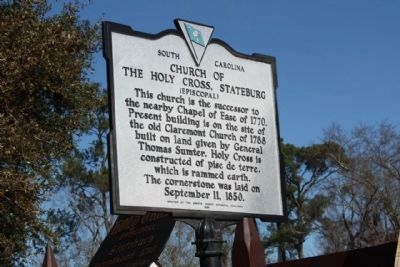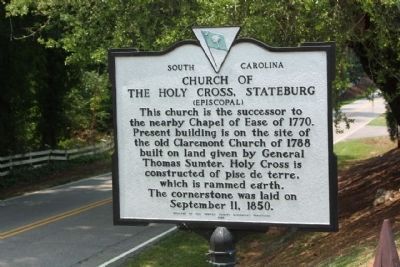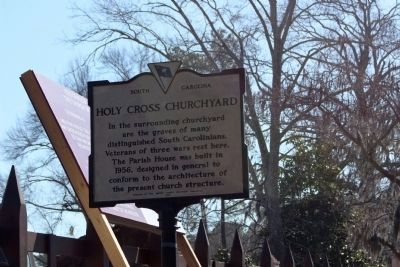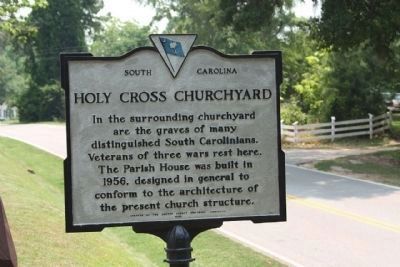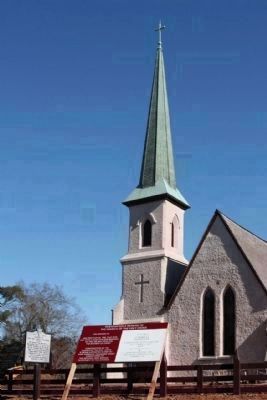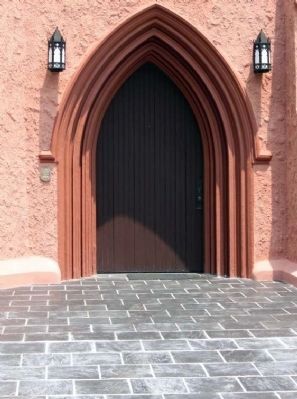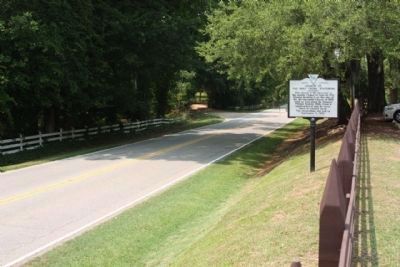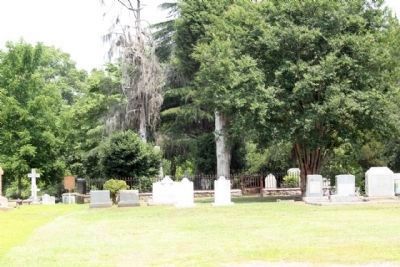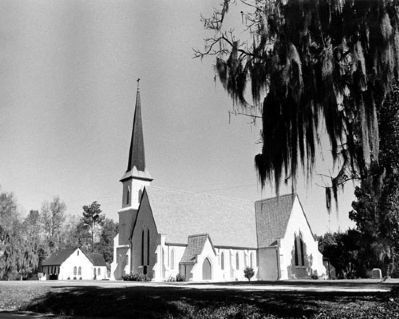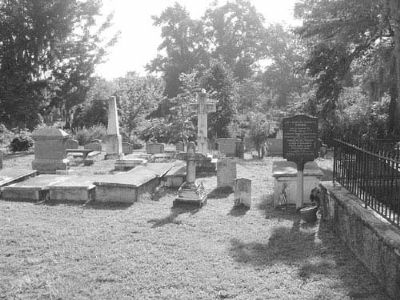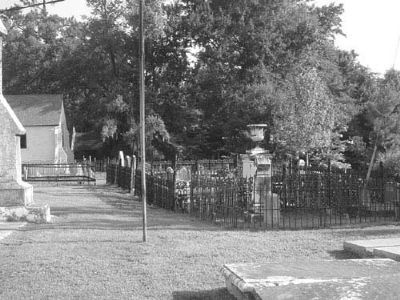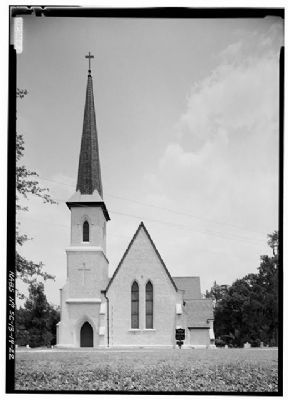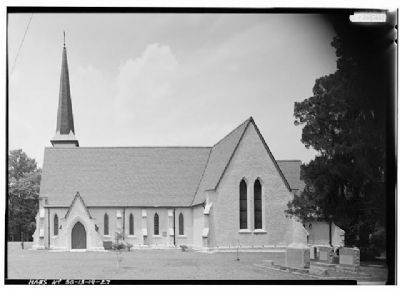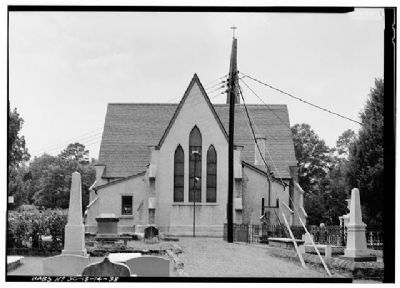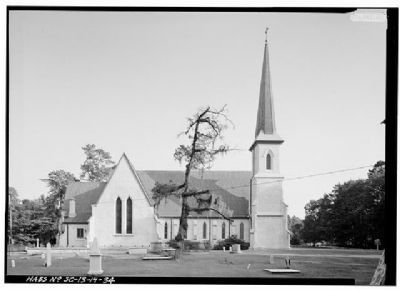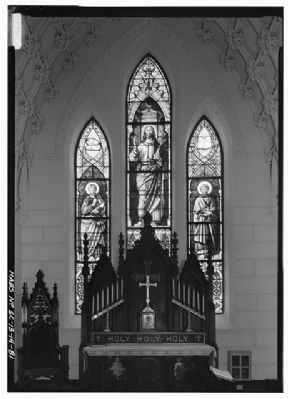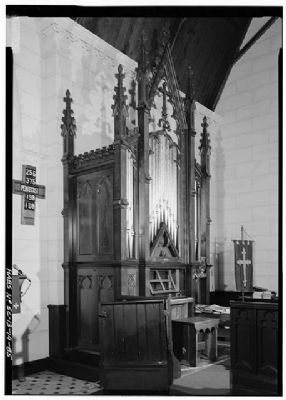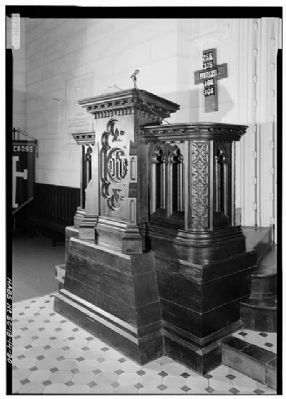Stateburg in Sumter County, South Carolina — The American South (South Atlantic)
Church of the Holy Cross Stateburg / Holy Cross Churchyard
Church of the Holy Cross, Stateburg. (Episcopal) This church is the successor to the nearby Chapel of Ease of 1770. Present building is on the site of the old Claremont Church of 1788, built on land given by General Thomas Sumter. Holy Cross is constructed of pise de terre, which is rammed earth. The cornerstone was laid on September 11, 1850.
Holy Cross Churchyard. In the surrounding churchyard are the graves of many distinguished South Carolinians. Veterans of three wars rest here. The Parish House was built in 1956, designed in general to conform to the architecture of the present church structure.
Erected 1958 by The Sumter County Historical Commission. (Marker Number 43-12.)
Topics and series. This historical marker is listed in this topic list: Churches & Religion. In addition, it is included in the National Historic Landmarks series list. A significant historical month for this entry is September 1916.
Location. 33° 57.195′ N, 80° 31.954′ W. Marker is in Stateburg, South Carolina, in Sumter County. Marker is on North Kings Highway (State Highway 261), on the right when traveling north. Located north of Deveaux Road. Touch for map. Marker is in this post office area: Sumter SC 29154, United States of America. Touch for directions.
Other nearby markers. At least 8 other markers are within 3 miles of this marker , measured as the crow flies. Church of the Holy Cross (a few steps from this marker); a different marker also named Church of the Holy Cross (within shouting distance of this marker); Joel Roberts Poinsett (within shouting distance of this marker); Battle of Stateburg (approx. half a mile away); Early Charleston Road (approx. 0.7 miles away); William Tennent (approx. 0.8 miles away); Battle of Beech Creek / The Civil War Ends In S.C (approx. 1.4 miles away); High Hills Baptist Church (approx. 2.2 miles away). Touch for a list and map of all markers in Stateburg.
Regarding Church of the Holy Cross Stateburg / Holy Cross Churchyard. Built in 1850, Holy Cross is of Gothic Revival design and is constructed of yellow pise de terre (rammed earth). Walls constructed of pise de terre (minimum depth of 13 inches) are almost impervious to earthquakes. Edward C. Jones of Charleston, designer of Holy Cross, was one of the best known South Carolina architects of the antebellum era. The cruciform Holy Cross is considered one of Jones’s most unusual designs. It resembles an Old World Parish Church. The high-pitched roof is of red tile. The interior features Bohemian stained glass windows designed by Violett de Duc and a rare Henry Irwin organ. Holy Cross is significant in that it, along with various other structures in Stateburg, comprises the largest complex of pise de terre buildings in the United States. Buried in the graveyard of Holy Cross is Joel R. Poinsett, a U.S. Congressman, Minister to Mexico, Secretary of War, and first president of the forerunner of the Smithsonian Institution, who is best remembered for bringing the poinsettia flower to this country from Mexico. Listed in the National Register November 7, 1973; Designated a National Historic Landmark November 7, 1973. ( S.C. Dept. of Archives and History )
Also see . . .
1. Church of the Holy Cross, Wikipedia entry. (Submitted on February 3, 2010, by Mike Stroud of Bluffton, South Carolina.)
2. A Brief History of The Church of The Holy Cross. The Church of the Holy Cross has weathered earthquake, tornado, and hurricane damage... (Submitted on February 3, 2010, by Mike Stroud of Bluffton, South Carolina.)
3. South Carolina Department of Archives and History entry for the Church of the Holy Cross. (Submitted on February 4, 2010.)
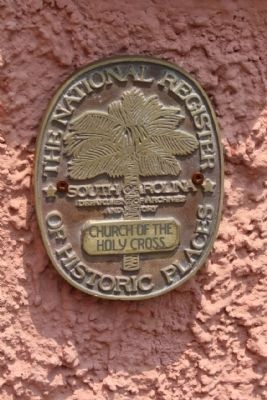
Photographed By Mike Stroud, June 2, 2011
6. Church of the Holy Cross, National Register of Historic Places Medallion
Holy Cross Episcopal Church *** (added 1973 - - #73001732)
Also known as Church of the Holy Cross
♦ Historic Significance: Architecture/Engineering ♦ Architect, builder, or engineer: Unknown ♦ Architectural Style: Gothic Revival ♦ Area of Significance: Architecture ♦ Period of Significance: 1850-1874 ♦ Owner: Private ♦ Historic Function: Religion ♦ Historic Sub-function: Religious Structure ♦ Current Function: Religion ♦ Current Sub-function: Religious Structure
♦ Historic Significance: Architecture/Engineering ♦ Architect, builder, or engineer: Unknown ♦ Architectural Style: Gothic Revival ♦ Area of Significance: Architecture ♦ Period of Significance: 1850-1874 ♦ Owner: Private ♦ Historic Function: Religion ♦ Historic Sub-function: Religious Structure ♦ Current Function: Religion ♦ Current Sub-function: Religious Structure
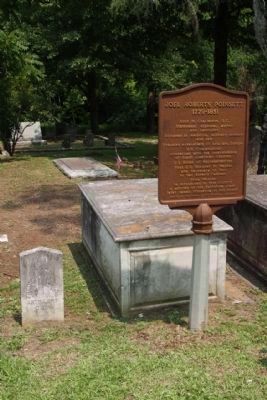
Photographed By Mike Stroud, 2011
10. Holy Cross Churchyard , Joel Roberts Poinsett grave
Mr. Poinsett collected cultural and horticultural artifacts the world over and was an accomplished amateur botanist.In 1826, he brought the plant home to the United States, and it was first called "painted leaf" and "Mexican fire plant." Later, it was renamed POINSETTIA (Poinsettia pulcherrima) in his honor.
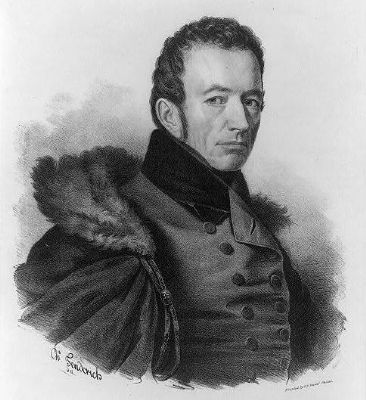
National potrait Gallery Smithsonian Institution, by Frederich, 1838
11. Joel Roberts Poinsett
was born on March 2nd, 1779 in Charleston, South Carolina. As a very educated young person he was fluent in French, Spanish, Italian, and German. He had studied medicine, law, and military science. Early on he had the opportunity to travel in Europe and Asia from 1801-1804 and 1806-1808. He returned home amid indications of war with Great Britain and was a special agent to the South American states from 1810-1814. He served in the South Carolina state legislature from 1816 to 1820; was chairman of the state's Board of Public Works from 1818 to 1820; and served in the U.S. House of Representatives from 1821 to 1825. He served as special envoy to Mexico in 1822 through 1923. While in Mexico, he advocated the causes of South American republics and Greek independence. He was even offered a commission in the
Russian army. In 1925 President Madison appointed him as the first ambassador to Mexico. In 1830, he returned home to South Carolina to espouse the Unionist's cause in nullification quarrels from 1830 to 1833. In 1833, he married Mary Izard Pringle. He also spearheaded what is now known as the Smithsonian Institution. He expanded the operations of West Point.
But throughout all these endeavors, Mr. Poinsett collected cultural and horticultural artifacts the world over and was an accomplished amateur botanist. Brother Poinsett became fascinated with the native Euphorbia pulcherrima, whose "petals" are actually bracts surrounding clusters of tiny yellow flowers. In 1826, he brought the plant home to the United
States, and it was first called "painted leaf" and "Mexican fire plant." Later, it was renamed POINSETTIA (Poinsettia pulcherrima) in his honor.
Brother Poinsett is recorded as having been Past Master of Recovery Lodge No. 31, Greenville, and Solomon's Lodge No. 1, Charleston, South Carolina. In 1821, Brother Poinsett was elected Deputy Grand Master of the Grand Lodge of South Carolina, but was never able to serve as Grand Master, because of his appointment as Secretary of War (1837-1841) under
President Van Buren. He did serve as Grand High Priest in South Carolina (1821-1841). At the request of Mexican Freemasons, he sent for charters for five lodges, which were granted by the Grand Lodge of New York. Subsequently, he helped establish the Grand Lodge of Mexico, and is credited with introducing Royal Arch Masonry to Mexico.
At the age of 72 he died at the home of his doctor in Statesburg, South Carolina.In his honor, Poinsett State Park has been created in S.C.
Credits. This page was last revised on March 18, 2024. It was originally submitted on February 3, 2010, by Mike Stroud of Bluffton, South Carolina. This page has been viewed 1,893 times since then and 68 times this year. Photos: 1. submitted on February 3, 2010, by Mike Stroud of Bluffton, South Carolina. 2. submitted on June 2, 2011, by Mike Stroud of Bluffton, South Carolina. 3. submitted on February 3, 2010, by Mike Stroud of Bluffton, South Carolina. 4. submitted on June 2, 2011, by Mike Stroud of Bluffton, South Carolina. 5. submitted on February 3, 2010, by Mike Stroud of Bluffton, South Carolina. 6, 7. submitted on June 5, 2011, by Mike Stroud of Bluffton, South Carolina. 8, 9. submitted on June 2, 2011, by Mike Stroud of Bluffton, South Carolina. 10, 11. submitted on June 4, 2011, by Mike Stroud of Bluffton, South Carolina. 12, 13, 14. submitted on February 3, 2010, by Mike Stroud of Bluffton, South Carolina. 15, 16, 17, 18, 19, 20, 21. submitted on May 13, 2010, by Mike Stroud of Bluffton, South Carolina. • Craig Swain was the editor who published this page.
